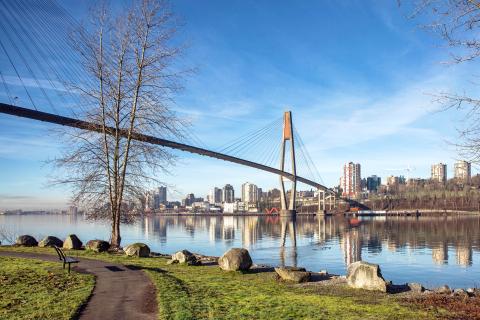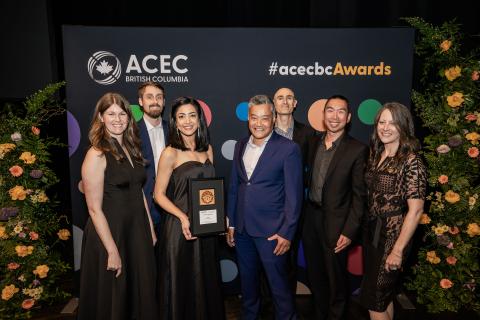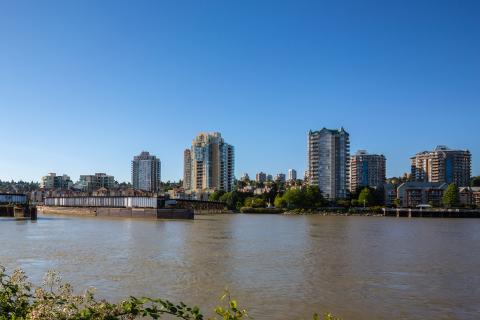-

-

Photo courtesy of ACEC-BC
-

How do you reduce risk and improve reliability of an aging pipeline? With first-of-its-kind in British Columbia and award-winning delivery.
Just look at the Jacobs team who worked with Metro Vancouver to rehabilitate an aging sewer pipeline in the City of New Westminster.
Established as British Columbia’s first capital city, the City of New Westminster today is known for the innovation and culture it brings to the Lower Mainland region, one of the largest and most densely populated areas of British Columbia. Metro Vancouver provides regional utility services, including managing a wastewater system that processes around 264,000 gallons (more than one billion liters) of wastewater every day from 2.7 million residents. A key piece of their sewer system is the New Westminster Interceptor (NWI).
Originally constructed in 1971, the NWI moves up to 1,479 gallons (5,600 liters) of sewage per second to Metro Vancouver’s Annacis Island wastewater treatment plant. A portion of this pipeline runs along the city’s busy Columbia Street, the New Westminster’s main commercial hub.
Following a series of temporary repairs on this nearly mile-long (1.6 kilometer) stretch of the NWI over the last 20 years due to rapid degradation from the corrosive sewage gases, Metro Vancouver engaged us to rehabilitate the deteriorating sewer, restore its structural and operational integrity, meet future flows, and provide a barrier against future corrosion.
Overcoming challenges…
Columbia Street and the surrounding downtown areas are some of the oldest parts of New Westminster. This meant a higher chance of encountering undocumented or poorly documented underground utilities and structures during construction. Add into this unprecedented weather conditions – including an atmospheric river event where 5.5-inches (140-millimeters) of rain fell over a two-day stretch – and this project wasn’t your typical sewer rehab.
We worked with Metro Vancouver and the contractor to develop a rehabilitation program that met engineering and operational requirements, was feasible to construct and was mindful of public impacts, including balancing construction with the busy summer period on Columbia Street – where a high volume of shoppers moved about and frequent summer events such as street festivals took place.
Pivotal to keeping the project on a pathway to success?
- Optimized methodology: Tapping into our industry and technical knowledge, we recommended live sliplining for the rehabilitation, knowing it could overcome the high peak velocities and surcharge conditions in the sewer system. Sliplining is a trenchless technology that requires less digging and is often quicker to complete than other repair methods. This methodology also eliminated the high bypass cost as the new glass reinforced pipe (GRP) was sliplined under live flows.
- Risk mitigation: The combined risk of potential sewer collapse and live sliplining in a high-velocity sewer required a variety of risk mitigation measures, such as emergency sewer closure systems, construction traffic loading management, and overlapping design and procurement timelines to implement a timely solution.
- Technical flexibility: We approached each challenge, from varying weather and unknown site conditions to public impacts and poor lateral conditions, with an eye toward the long-term project interests. We stayed flexible throughout design, operations and maintenance, constructability and contract administration. In the face of each new hurdle, we brainstormed options with Metro Vancouver and the contractor, weighed their merits, and together decided on the path forward to minimize delays and costs.
… for an award-winning result and community benefit
Our collaborative solutions eliminated the immediate risk of catastrophic failure and delivered a sewer that’s now operationally safe and provides continued reliability to serve the community with a 75+ year design life. The NWI Columbia Section Rehabilitation project also represents the largest diameter and longest distance of live sliplining in the region to date.
Utility owners and engineers now have local proof-of-concept for this trenchless technology under varying conditions, which can not only be applied to large-diameter regional sewers, but to hundreds of miles of municipal sewers as well. Trenchless technologies, like sliplining, also reduce emissions on rehabilitation efforts in comparison to traditional construction methods.
On the NWI Columbia Section Rehabilitation project, we calculated the emissions, using the North American Society of Trenchless Technology’s Trenchless Technology Calculator, that would be produced for the just over half a mile (~ 1 kilometer) of pipe that we replaced with live sliplining, compared to open cut installation. The results showed that live sliplining on this portion of the project provided a significant benefit: taking more than 1,000 trucks off the road, reducing earthworks and hauling, saving hundreds of thousands of gallons of diesel, and mitigating over 600 CO₂. tons of emissions. This didn’t even account for emissions associated with decommissioning the existing pipeline and utility relocations that would’ve been required to do a traditional open cut construction!
Adopting these rehabilitation methods on future projects will greatly reduce the social and environmental impacts of replacing/rehabilitation the communities’ aging infrastructure in the future.
So, it’s no wonder, with benefits like these, that The Association of Consulting Engineering Companies British Columbia recently recognized our work on the NWI Columbia Section Rehabilitation project with the Award of Excellence in the Municipal and Civil Infrastructure category.
“The New Westminster Interceptor Columbia Section Rehabilitation project represents a defining moment for trenchless technology,” says Jacobs Vice President and Global Water Director Susan Moisio. “Our work with Metro Vancouver proves that large-diameter live sliplining is a viable methodology for future rehabilitation projects. It’s also a significant milestone, as the longest and largest-diameter instance of sliplining completed in the lower mainland region of British Columbia, and the recognition from ACEC-BC is a testament to that.”
“Throughout this project, we balanced congested work areas, varying and extreme flow conditions, historical market conditions, social and environmental impacts and efficient use of public funds to minimize the high cost of living in our communities,” adds Jacobs Senior Vice President Chrissy Thom. “As more large-diameter infrastructure reaches the end of its useful life and needs replacement in the near future, this project can be used as a case study in trenchless rehabilitation solutions and serve as a reference point for future projects striving to provide lasting impacts for the community.”
Did you know?
-
1 K+
trucks taken off the road thanks to using trenchless rehabilitation methods on this project
-
75 +
year design life on the new sewer pipeline
-
600 +
CO₂ tons of emissions mitigated by using live sliplining method for rehabilitation on this project
-
~ 1
mile long (1.6 km) rehabilitation of the Columbia Section includes the largest diameter and longest distance of live sliplining in British Columbia’s lower mainland region to date
About water conveyance and storage at Jacobs
From the conveyance and storage of treated and raw water to the collection of wastewater, reclaimed water and stormwater, Jacobs provides a variety of urban conveyance and storage solutions for projects of all sizes, incorporating new technology and adapting to changing environmental conditions on every project. We’re ranked as the No. 1 design firm in Water Transmission Lines and Sanitary & Storm Sewers by Engineering News Record and have proudly held one of the top spots on Trenchless Technology’s Top 50 Trenchless Engineering Firms list for the last eight years (and counting!)












































